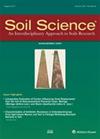Supplementary material to "Soil nitrogen and water management by winter-killed catch crops"
4区 农林科学
Q2 Agricultural and Biological Sciences
引用次数: 2
Abstract
Abstract. Improving N cycling in agroecosystems is one of the key challenges in reducing the environmental footprint of agriculture. Further, uncertainty in precipitation makes crop water management relevant in regions where it has not been necessary thus far. Here, we focus on the potential of winter-killed catch crops to reduce N leaching losses from N mineralization over the winter and soil water management. We compared four single catch crops (white mustard, phacelia, Egyptian clover and bristle oat) and a fallow treatment with two catch crop mixtures with 4 and 12 plant species (Mix4 and Mix12). High-resolution soil mineral N (Nmin) monitoring in combination with modelling of spatiotemporal dynamics served to assess N cycling under winter-killed catch crops, while soil water was continuously monitored in the rooting zone. Catch crops depleted the residual Nmin pools by between 40 and 72 % compared to the fallow. The amount of residual N uptake was lowest for clover and not significantly different among the other catch crops. Catch crops that produce high N litter materials, such as clover and mustard leaves, showed an early N mineralization flush immediately after their termination and the highest leaching losses from litter mineralization over the winter. Except for clover, all catch crops showed Nmin values between 18 and 92 % higher on the sowing date of the following maize crop. However, only Mix12 was statistically significant. Catch crops depleted the soil water storage in the rooting zone during their growth in autumn and early winter, but preserved water later on when their residues cover the ground. The shallow incorporation of catch crop residues increased water storage capacity during the cropping season of the main crop even under drought conditions. Hence, catch cropping is not just a simple plant cover during the winter but improved the growth conditions for the following crop at decreased N losses. Mixtures have been shown to compensate for the weaknesses of individual catch crop species in terms of nutrient capture, mineralization and transfer to the following main crop as well as for soil water management. Detailed knowledge about plant performance during growth and litter mineralization patterns is necessary to make optimal use of their full potential.“冬杀捕捞作物对土壤氮素和水分的管理”的补充材料
摘要改善农业生态系统中的氮循环是减少农业环境足迹的关键挑战之一。此外,降水的不确定性使得作物水分管理在迄今为止还不需要的地区具有相关性。在这里,我们关注冬杀作物在减少冬季氮矿化造成的氮淋失和土壤水分管理方面的潜力。我们比较了四种单一捕获作物(白芥菜、长穗草、埃及三叶草和硬毛燕麦)和两种捕获作物混合物(Mix4和Mix12)的休耕处理。采用高分辨率土壤矿质氮(Nmin)监测与时空动态建模相结合的方法,评估了冬杀作物下的氮素循环,同时对生根区土壤水分进行了连续监测。与休耕相比,捕捞作物耗尽了剩余的Nmin池40%至72%。三叶草的残氮吸收量最低,与其他作物间差异不显著。生产高氮凋落物的捕获作物,如三叶草和芥菜叶,在其终止后立即显示出早期的氮矿化,并且在冬季凋落物矿化的淋失量最大。除三叶草外,所有捕获作物的Nmin值在其后玉米作物的播种日期高出18%至92%。但只有Mix12具有统计学意义。在秋冬初生季,捕鱼业作物在其生长过程中耗尽了生根区土壤储水量,但在后期其残体覆盖地面时保留了水分。即使在干旱条件下,在主要作物的种植季节,捕获作物残茬的浅层掺入也增加了储水能力。因此,在减少氮素损失的情况下,捕捞作物不仅是冬季的简单植物覆盖,而且改善了后续作物的生长条件。混合已被证明可以弥补单个捕获作物物种在养分捕获、矿化和向下一个主要作物转移以及土壤水分管理方面的弱点。详细了解植物生长过程中的性能和凋落物矿化模式是充分利用其潜力的必要条件。
本文章由计算机程序翻译,如有差异,请以英文原文为准。
求助全文
约1分钟内获得全文
求助全文
来源期刊

Soil Science
农林科学-土壤科学
CiteScore
2.70
自引率
0.00%
发文量
0
审稿时长
4.4 months
期刊介绍:
Cessation.Soil Science satisfies the professional needs of all scientists and laboratory personnel involved in soil and plant research by publishing primary research reports and critical reviews of basic and applied soil science, especially as it relates to soil and plant studies and general environmental soil science.
Each month, Soil Science presents authoritative research articles from an impressive array of discipline: soil chemistry and biochemistry, physics, fertility and nutrition, soil genesis and morphology, soil microbiology and mineralogy. Of immediate relevance to soil scientists-both industrial and academic-this unique publication also has long-range value for agronomists and environmental scientists.
 求助内容:
求助内容: 应助结果提醒方式:
应助结果提醒方式:


